**POSITION FILLED**
Overview and Purpose
Sea Turtle Conservancy (STC) is based in Gainesville, Florida, and was founded by renowned sea turtle expert Dr. Archie Carr. STC is the oldest and one of the most accomplished sea turtle conservation organizations in the world. STC is hiring a Lighting Project Specialist to work on our Sea Turtle Lighting Project. This person will work as part of our lighting team implementing sea turtle lighting retrofits on beachfront properties in Florida, assisting with educational workshops, and coordinating dune planting projects to help further reduce lighting impacts to nesting turtles. The National Fish and Wildlife Foundation has funded STC’s lighting project as part of its investment toward mitigating the impacts to sea turtles caused by the 2010 Deepwater Horizon Oil Spill. The project’s goal is to increase sea turtle survivorship by reducing hatchling disorientation caused by lighting. The project works with private property owners to retrofit problematic beachfront lighting to sea turtle friendly alternatives using the best available technology.
Duties and Responsibilities
The primary responsibilities of this position will be implementing sea turtle lighting retrofits and dune planting projects in the south west Florida peninsula. The position will involve collection of night-time photos and lighting measurements; contract negotiations with property owners and managers; developing exterior lighting plans; communicating with property owners and lighting distributors; and data entry, management, analysis and mapping using Access, Excel and ArcGIS Online. Travel to the south west Florida peninsula and other parts of the state over 3 to 5 day periods will be required. Duties also will include coordinating travel logistics; tracking the progression of multiple projects in various stages; and conducting lighting workshops developed for code enforcement and building professionals. The position will require flexible work hours, occasionally at night and on the weekends. The Lighting Project Specialist will be based in Gainesville and work directly under the Lighting Project Manager as part of a four-person team of lighting specialists.
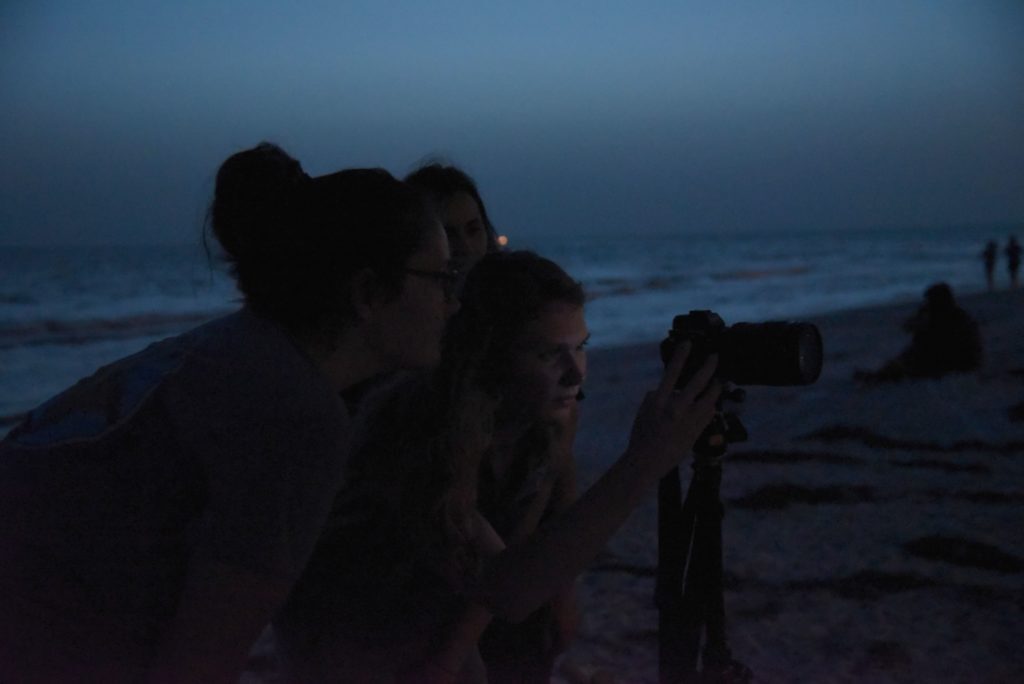
Minimum Qualifications


Salary and Benefits
Applications will be accepted until a candidate is selected. A start date prior to the end of 2019 is preferred. Apply by submitting your cover letter and résumé to the Project Manager at Rachel@conserveturtles.org.

Sea Turtle Conservancy is excited to announce that we’ve made it onto the Top Responsible Costa Rica Eco Tours 2019 list!
Curated by Terra Incognita – a social enterprise seeking to promote the best examples of ethical ecotourism worldwide – we’re part of a group of nearly 40 incredible tours across Costa Rica working to conserve the environment, support the well-being of local people and educate visitors and hosts.
“Costa Rica is often the first place that comes to mind when we hear the word ‘ecotourism’, yet it can still be challenging for visitors to choose a responsible tour,” said Kristi Foster of Terra Incognita.
 The list includes a transparent explanation of how all tours contribute to conservation, local communities and education, and is open to reviews from guests who’ve participated in the tours. Groups on the list are doing everything from cleaning up beaches and donating to community projects, to offsetting their carbon emissions and encouraging their guests to do the same. Some are actively contributing to conservation research, while others are empowering local conservation ambassadors through environmental education and capacity building.
The list includes a transparent explanation of how all tours contribute to conservation, local communities and education, and is open to reviews from guests who’ve participated in the tours. Groups on the list are doing everything from cleaning up beaches and donating to community projects, to offsetting their carbon emissions and encouraging their guests to do the same. Some are actively contributing to conservation research, while others are empowering local conservation ambassadors through environmental education and capacity building.
STC offers several different eco-tour options. Click below to learn more about each trip:

You can view the Responsible Costa Rica Eco Tours 2019 list at www.terra-incognita.travel and join a movement to create positive change for people and planet through travel.
To learn more about sea turtle experiences offered by STC, visit http://stcturtle.org/////get-involved-sea-turtle-experience/
***UPDATE as of 8/7/2019: Great news out of the Brevard County Commission meeting last night! The commissioners rejected the citizen initiative to allow dogs on 11 miles of the Refuge. Most of the commissioners were vocally opposed. In the Carr Refuge District, 92% of those contacting their commissioner via email and phone did not want dogs on their beaches. Commissioners cited both human health and safety and the sensitive habitat as reasons for not supporting the initiative. THANK YOU to all who signed our petition, called and emailed commissioners and spread the word about this harmful proposed initiative! You truly made a difference. If any news breaks about this issue in the future, we will be sure to keep you informed.***
ACTION ALERT: Tell Brevard County Commissioners to keep dogs off the Archie Carr National Wildlife Refuge
Brevard County’s Archie Carr National Wildlife Refuge hosts the single most important sea turtle nesting beach in the United States. The Refuge is a nesting ground for more threatened loggerhead turtles than virtually anyplace else on Earth, as well as for green and leatherback sea turtles. Decades of tireless work and millions of dollars spent by governmental agencies, non-profit organizations such as the Sea Turtle Conservancy (STC), and foundations successfully created and protected the Refuge as a safe haven for sea turtles. A recent movement to open up the Refuge to domestic dogs threatens this progress.
A group of local Brevard residents is pushing forward a proposal to allow dogs on 11.5 miles of the Refuge between 5 p.m. and 9 a.m. daily. STC has extensive experience in monitoring and protecting sea turtle nesting beaches in Florida and the Caribbean. On some of the beaches we monitor, dogs have been documented as a major threat to sea turtles; dogs are excellent at sniffing out turtle nests and digging them up. Dogs are also known to predate live hatchlings ready to emerge and scare off adult nesting sea turtles. Sea turtles, especially hatchlings, have plenty of wild predators without humans introducing large numbers of domestic predators.
This stretch of beach, owned by county, state and federal governments, falls under the U.S. Fish and Wildlife Service management plan that does not allow dogs and cats on federally-owned property. Brevard County would be highly vulnerable to a federal Endangered Species Act lawsuit if this plan moves forward and any impacts to sea turtle nests are documented. The Refuge is one of the most heavily studied nesting beaches in Florida, so any predation incidents by dogs would be swiftly recorded.
This year has been a record-breaking year for sea turtle nesting in the Refuge and across the Southeastern U.S. All three species of sea turtles that nest in the Carr Refuge are just starting to show signs of recovery. The Carr Refuge in Brevard County is the worst possible place to allow dogs on the beach.
Although many staff members at STC are dog lovers, we oppose directing dogs to defecate in the very area where people and children take their shoes off and play in the sand. It is highly unsanitary for people and very dangerous for federally-protected sea turtles.
The Brevard County Commission is meeting at 5 p.m. on Tuesday, August 6 to discuss this proposed plan. Please contact the Brevard County Commissioners listed below and let them know that you oppose opening up the Archie Carr Refuge to dogs.
District 1 Commissioner Rita Pritchett
321-607-6291
D1.Commissioner@BrevardFL.gov
District 2 Commissioner Bryan Lober (Vice Chair)
321-454-6601
D2.Commissioner@BrevardFL.gov
District 3 Commissioner John Tobia
321-633-2075
D3.Commissioner@BrevardFL.gov
District 4 Commissioner Curt Smith
321-633-2044
D4.Commissioner@BrevardFL.gov
District 5 Commissioner Kristine Isnardi (Chair)
321-253-6611
D5.Commissioner@BrevardFL.gov
Funded by a portion of revenues from Florida’s Sea Turtle Specialty License Plate, the Sea Turtle Grants Program distributes funds each year to support sea turtle research, conservation and education programs that benefit Florida sea turtles. In 2019, Sea Turtle Conservancy had two project proposals selected for funding.
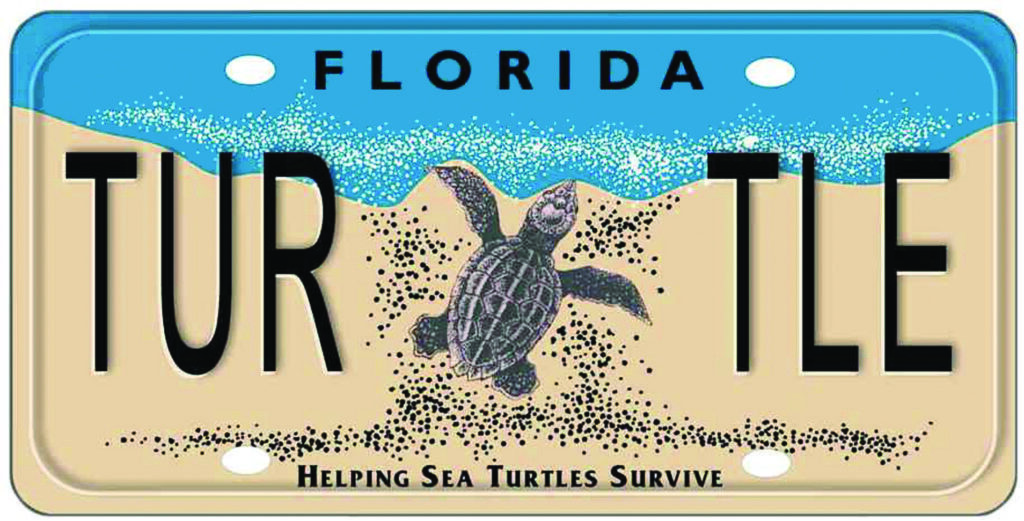
2019
Green Turtle Seasonal Movements and Group Behavior in Florida’s Big Bend – $27,600.00 awarded
In the Florida Keys, green turtles have showed signs of herding or coordinated movements over seagrass habitat. It’s possible this also occurs in the Big Bend during warmer months (May–September), however, it’s unclear how frequent juvenile green turtles actually associate with each other. This project will use telemetry to determine migratory movements of juvenile green turtles due to changes in water temperatures and investigate localized group behavior during the spring, summer and fall. ARGOS satellite transmitters will be placed on juvenile green turtles that are captured at four different sites in the Big Bend. Their movement patterns will be analyzed using state-space models and ArcGIS spatial analysis tools. The results will help explain large scale seasonal movements as well as small scale group behavior that may be impacted in the future by climate change and the loss of habitat.

FWC Permit #118
Upgrading Sea Turtle Lighting Education Program – $18,930.00 awarded
Sea Turtle Conservancy (STC) will refurbish and update the traveling lighting displays funded by the grants program in 2014. Since their creation, the displays have successfully been hosted at facilities throughout the state of Florida and have been viewed by hundreds of thousands of people. The four portable displays have received considerable wear since they were first created and deployed. STC will work with the original graphics company to reprint the panel graphics; add a protective coating on each panel to prevent scratching; and repair and update damaged and outdated fixtures. Once the displays are repaired, STC will re-deploy them in high-traffic locations in southwest Florida, where STC will expand its separately-funded sea turtle lighting retrofit program. STC will also work with a video production company to create a short instructive video to further educate beachfront property owners about the importance of sea turtle lighting and how to be part of the solution. This video will be broadcast to targeted audiences in SW Florida through boosted social media postings.

To learn more about the Sea Turtle Grants program, visit www.helpingseaturtles.org.

Photo credit: Rachel Smith
Nesting season officially kicked off on May 1st in Florida, where about 90% of sea turtle nesting in the U.S. takes place. Whether you are a Florida resident or are simply stopping by for summer vacation, this information will help you get the most out of our beautiful beaches while also being considerate of nesting sea turtles and hatchlings. Share this information with your beach-loving family and friends to ensure that our beaches can be safely and responsibly enjoyed by all!
Human threats that can interfere with the nesting and hatching process include:
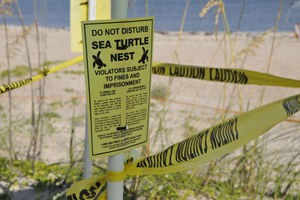 Sandcastles: knock them down! The flatter the beaches are, the easier it will be for nesting sea turtles and hatchlings to safely make it to and from the water. We know you worked very hard on your masterpiece and are sorry to see it go, but the turtles appreciate it.
Sandcastles: knock them down! The flatter the beaches are, the easier it will be for nesting sea turtles and hatchlings to safely make it to and from the water. We know you worked very hard on your masterpiece and are sorry to see it go, but the turtles appreciate it.Want a chance to see a nesting loggerhead sea turtle? Attend a Turtle Walk! STC’s Turtle Walks take place in the Archie Carr National Wildlife Refuge, starting at the Barrier Island Center in Melbourne Beach, FL. Participants have the chance to witness a nesting loggerhead sea turtle. Walks are conducted by STC on Monday, Tuesday, Thursday, and Friday nights in June and July. Space is limited to 20 people per night. Cost is $15 per person. Click here to reserve your spot!
Exciting news! Sea Turtle Conservancy’s main office located in Gainesville, FL is moving to a new building! What does this mean for you? Due to the move, STC will have limited or no access to phones from April 17-22 and limited email access April 19-22.
Any gift Shop or Adopt-A-Turtle orders placed after 5 pm (EST) on Wednesday, April 17 will not be processed until Wednesday, April 24.
We appreciate your patience at this busy time!
Our new address is:
Sea Turtle Conservancy
4581 NW 6th Street
Suite A
Gainesville, FL 32609
All email addresses and phone numbers will remain the same.
Single-use plastics pose a threat to all marine life, but especially to sea turtles. Researchers from the University of Exeter recently found single use plastics and fibers in the gut of all 102 sea turtles they sampled in 2018. Without a major global effort to reduce the consumption of single-use plastics, there could be more plastic in the ocean than fish by 2050.
After a video of a sea turtle with a straw in its nose went viral in 2015, a global plastic-free movement has been gaining momentum. Corporations such as Starbucks, McDonald’s, Delta Airlines, and Marriott recently announced changes to their plastic policies to protect marine life. In Florida, Sea Turtle Conservancy works with coastal restaurants to change their straw policies and to empower their guests to make conservation-minded decisions. Local governments in Florida are also introducing restrictions on plastic bags and single-use cutlery.
This effort may be in jeopardy. Florida Senator Hutson filed a bill in January, Senate Bill 588, which seeks to stop local governments from passing laws to reduce plastic consumption in their communities. In particular, the bill will invalidate all existing straw bans in Florida and will prevent local governments from banning straws in the future. This bill, disguised as an effort to reduce plastic consumption, will freeze the efforts of local governments to make decisions about their own neighborhoods. You can read the bill in full by clicking here. Check out this recent article from the Tampa Bay Times for more on the issue.
Sea Turtle Conservancy does NOT support SB-588 because we SUPPORT bans of plastic bags, cutlery, Styrofoam and straws to reduce potential harm of sea turtles by marine debris. Sea Turtle Conservancy does support House Bill 6033, filed by Representative Grieco and co-sponsored by Representative Eskamani, which proposes to restore the ability for local governments to ban plastic bags.
We need your help! On Monday, March 4 at 1 p.m., members of the Florida Senate’s Commerce and Tourism committee will vote on Senate Bill 588. Please let committee members know your feelings about this bill by emailing or calling them using the contact information below.
Personalized comments are the most effective, especially if any of these committee members are in your district in Florida. Here is a short example of what you can say:
“My name is _____ and I ask that you vote “No” on Senate Bill 588. I oppose Senate Bill 588 because plastic debris kills wildlife every year, including endangered sea turtles. Straw bans are an effective way to reduce plastic consumption and protect marine life from possible plastic ingestion. There is a global movement to reduce plastic use at the local, state and federal level. Senate Bill 588 will freeze that progress and prevent local governments from making decisions that impact their own communities.”
Senator Travis Hutson (bill sponsor)
(850) 487-5007
hutson.travis@flsenate.gov
Senator Victor Torres
(850) 487-5015
torres.victor@flsenate.gov
Senator Joe Gruters
(850) 487-5023
gruters.joe@flsenate.gov
Senator Linda Stewart
(850) 487-5013
stewart.linda@flsenate.gov
Senator Tom Wright
(850) 487-5014
wright.tom@flsenate.gov
Guest blog post by Diane & Linda Randgaard
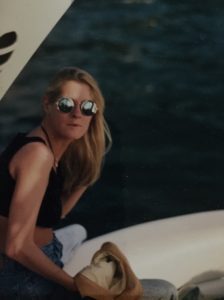 Our younger sister, Lisa, loved to travel and did so with great joy and wonder. The decline of her physical health from the congenital heart condition she lived with so bravely was a limit she recognized, once noting that her body “wouldn’t be able to keep up with her desire to see the world.”
Our younger sister, Lisa, loved to travel and did so with great joy and wonder. The decline of her physical health from the congenital heart condition she lived with so bravely was a limit she recognized, once noting that her body “wouldn’t be able to keep up with her desire to see the world.”
Lisa found other ways to indulge her wanderlust, and sea turtles helped fill a need in her soul. STC’s annual Tour de Turtles was of particular interest, tracking strong, yet vulnerable, animals that traverse wide swaths of the world’s vast, dangerous oceans. She shared her passion for sea turtles with others and donated to this cause that grew near and dear to her. When Lisa died suddenly at age 43 in May 2012, she left a grieving family that got busy and began fundraising for STC in her honor.
 This Holiday Season, we are offering our handmade soaps and other special items to raise $3,000 by January 2019, building on the $100,500 generated since the start of this amazing journey. In 2016, Lisa’s Building, which houses staff and welcomes visitors, was dedicated at the STC outpost in Tortuguero, Costa Rica, a crucial nesting beach for greens and leatherbacks, and 100% of ALL holiday donations goes to the Lisa Jo Randgaard Fund, an unrestricted endowment fund focused on the future of sea turtle conservation.
This Holiday Season, we are offering our handmade soaps and other special items to raise $3,000 by January 2019, building on the $100,500 generated since the start of this amazing journey. In 2016, Lisa’s Building, which houses staff and welcomes visitors, was dedicated at the STC outpost in Tortuguero, Costa Rica, a crucial nesting beach for greens and leatherbacks, and 100% of ALL holiday donations goes to the Lisa Jo Randgaard Fund, an unrestricted endowment fund focused on the future of sea turtle conservation.
Lisa’s heart goes on, thanks to the kindness of many wonderful people that share her great love of sea turtles.
THANK YOU and Happy Holidays! Please visit us at LoveIntoSustainedAction.com.
Sea Turtle Conservancy (STC) would like to give a special congratulations to the winners of our 2019 Sea Turtle Scenes Calendar Contest! All of the photos were truly fantastic. Thank you to everyone who took the time to enter!
The winning photographs will be featured in STC’s 2019 Sea Turtle Scenes Calendar, which will be available online in our gift shop sometime in November. Thank you to all of our participants who made this year’s selection exciting and especially difficult. We received HUNDREDS of submissions! If you missed out on this one, look out for the 2020 photography contest next year!
Here are this year’s winners:
**Cover Image!** Photographer: Ben Hicks
January: Photographer David Randazzo
February: Photographer Karla Morales
March: Photographer Ben Hicks
April: Photographer Guillermo Plaza
May: Photographer Dirk Peterson
June Photographer: Karla G Barrientos Munoz
July: Photographer Hannah Bacalla
August: Photographer Jim Angy
September: Photographer David Randazzo
October: Photographer Mario Cisneros
November: Photographer Jim Angy
December: Photographer Saira Ortega
STC’s Executive Director David Godfrey was recently interviewed by NBC Nightly News to discuss the importance of sea turtle friendly lighting in Florida, which STC has played a major role in implementing across the state. The story aired live on September 22, 2018 and can be viewed on NBC’s website by clicking the image below:
Sea Turtle Conservancy now has a certified Lighting Specialist I on staff! Lighting Project Manager Rachel Tighe recently received her Lighting Specialist I certification through the National Association of Innovative Lighting Distributors (NAILD).

STC Lighting Project Manager Rachel Tighe discusses a recently completed lighting retrofit with the General Manager & Operating Manager of the Holiday Inn Express Pensacola Beach.
The training allowed Rachel to increase her knowledge and gain expertise in lighting basics and luminaire application. This adds competence and confidence to the team and enhances STC’s ability to offer the best sea turtle friendly lighting solutions while maintaining human safety and security. We are now able to more effectively educate and communicate with property owners about the benefits of sea turtle friendly lighting.

The STC lighting team takes a meter reading and records the data in our online geodatabase system during a night evaluation in Perdido Key.
It is STC’s hope that the certification will help foster and maintain relationships with other lighting professionals in the industry. We are now better equipped to teach lighting professionals about sea turtle friendly lighting so they can better assist us in darkening sea turtle nesting habitat.
To learn more about STC’s Beachfront Lighting program, click here!
 Over the last five years, the Randgaard family has raised $100,000 for Sea Turtle Conservancy to honor the memory of their beloved youngest daughter and sister, Lisa, who passed away at the age of 43 on May 2, 2012, from complications of her congenital heart condition.
Over the last five years, the Randgaard family has raised $100,000 for Sea Turtle Conservancy to honor the memory of their beloved youngest daughter and sister, Lisa, who passed away at the age of 43 on May 2, 2012, from complications of her congenital heart condition.
The family helped fund the renovation of The Lisa Randgaard Building in Tortuguero, Costa Rica, to provide safe, eco-friendly housing and office space at this STC research outpost for staff, scientists, volunteers and other visitors.
Fundraising by Lisa’s mom, Jenny, and two sisters, Diane and Linda, centered on building The Lisa Jo Randgaard Fund, includes “Lisa’s Fundanas,” custom sea turtle-themed bandanas, and “Flippery When Wet” homemade soap bars.
When Jenny passed away in October 2016, her daughters knew they gained another angel on their shoulder to guide them in their work. “In addition to our soap bars, we are going to reissue, after heartwarming demand, a limited run of our ‘Lisa’s Fundanas.’ Helping sea turtles is a great way to honor Lisa and Mom.”
To purchase one of “Lisa’s Fundanas” or “Flippery When Wet” soaps, visit www.LoveIntoSustainedAction.com
It’s that time of the year again; nesting season is here in the state of Florida! The majority of nesting in Florida occurs between May 1st and October 31st. About 90% of all sea turtle nesting in the United States takes place on Florida’s beaches, which means it is critical that residents and visitors alike do their part to ensure that sea turtles have a safe and successful nesting season. By reading the tips below, you can do your part to make sure they’re made part of your beach routine!

Loggerhead returns to sea after nesting (Photo Credit: Blair Witherington)
Use sea turtle-friendly lights or no lights at all! In order to prevent nesting and hatchling turtles from wandering off track, your beachfront property should use sea turtle friendly lighting. You can also help by closing drapes and blinds, and shield or turn off outdoor lights that are visible on the beach. Sea turtle hatchlings can become easily disoriented by bright lights on the coast from hotels and beachfront properties. By following these steps, you can encourage females to nest and lead hatchlings in the right direction, the ocean!
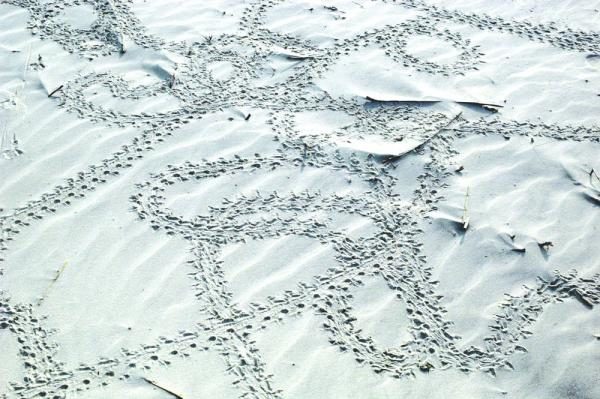
Tracks from disoriented hatchlings. Their tracks should lead straight to the sea.
Knock down sandcastles and fill in holes! Although this is every kid’s nightmare, it’s important to knock your sandcastle over and flatten out the sand at the end of the day. Additionally, filling in all holes made in the sand can avoid the entrapment of hatchlings while on their way to the water. Even the nesting mothers can become stuck in these holes when crawling up the beach to nest. Furthermore, remove all beach accessories, such as tents, umbrellas, toys, and chairs. These can prevent obstacles for both the mother and the hatchlings.
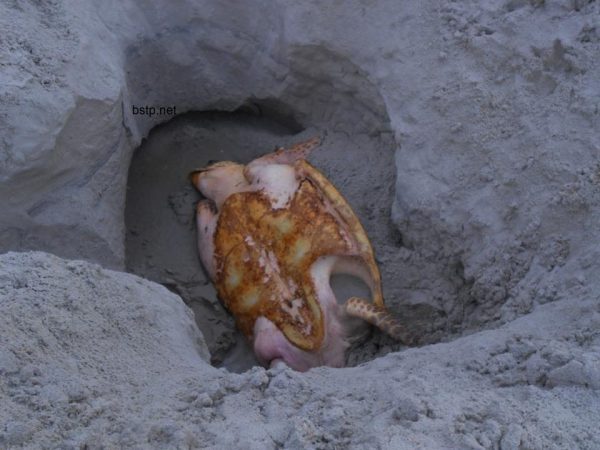
An adult loggerhead fell into a large hole on the beach and had to be rescued by Beaches Sea Turtle Patrol
Avoid the attraction of unwanted pests. Raccoon, foxes, coyotes and other types of animals all have one thing in common: they love our leftovers. Raccoons destroy thousands of sea turtle eggs each year and are one of the greatest causes of sea turtle mortality on Florida’s beaches. Leaving food outside for neighborhood dogs and cats also attracts raccoons. You can help deter these animals from destroying sea turtle eggs by cleaning up food and additional trash after a day at the beach.
Program the phone number for your area’s wildlife stranding hotline into your phone so you’ll be prepared if you happen to encounter a dead, sick, stranded or injured sea turtle. It is also important to report any harassment of sea turtles or disturbance of nests. In Florida, you can call FWC Wildlife Alert Number at 1-888-404-3922 or visit their website. For other states, you can find a list of contact info here.

Don’t interfere with the nesting or hatching process. It’s important to allow hatchlings to crawl to the water on their own. Many scientists believe the journey from nest to water allows them to imprint on their own beach. Picking up hatchlings may interfere with this process. It is also illegal to touch sea turtles under both federal and state laws.
Don’t place beach furniture too close to a marked nest. If possible, place furniture at least 5 feet away. Furniture can mislead turtles during the hatching process and also entrap them. Also make sure to put away your beach furniture at the end of the day as they become a dangerous obstacle for a nesting turtles.

Loggerhead turtle stuck under a chair that was left on the beach. Photo via Anna Maria Island Turtle Watch
Don’t use fireworks on the beach. Although this can be tempting with 4th of July right around the corner, think about how the loud noises and bright lights can disturb nesting females. Instead, many local organizations hold inland fireworks displays for your enjoyment. Bonfires on the beach also pose a danger to sea turtles.
If you would like to watch a nesting turtle, join an organized sea turtle walk. In Florida and other states where sea turtles nest, turtle watches are conducted by trained and permitted individuals. The goal is to educate people about sea turtles through direct contact, without disturbing the turtles. Click here for more information about registering to join an STC Turtle Walk.
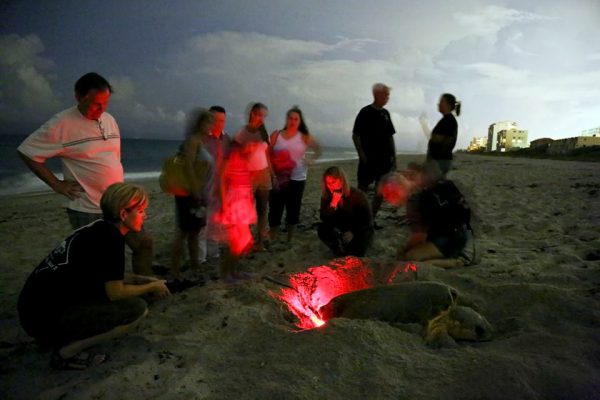
Photo courtesy Greg Lovett, Palm Beach Post (taken using long-exposure, no flash)
The Sea Turtle Grants Program (STGP), funded by the sale of Florida’s Helping Sea Turtles Survive specialty license plate, recently awarded $349,943.06 to 24 different projects benefiting Florida sea turtles as part of the 2018-2019 grant funding cycle.

Each year, the Sea Turtle Grants Program distributes money to coastal county governments, educational and research institutions and nonprofit groups through a competitive application process. The sea turtle specialty license plate is also the primary source of funding for the Florida Fish and Wildlife Conservation Commission’s Marine Turtle Protection Program.
The following organizations received grants for their approved projects for the 2018-2019 cycle:
The sea turtle plate is the number two overall selling specialty tag in Florida, and the number one environmental specialty plate. By purchasing the sea turtle specialty license plate, Floridians are voluntarily funding important programs to save endangered sea turtles and their habitats.
To learn more about the Sea Turtle Grants Program and the “Helping Sea Turtles Survive” specialty license plate, please visit www.helpingseaturtles.org.
The Bermuda Turtle Project, a joint research and protection program of the Sea Turtle Conservancy (STC) and the Bermuda Zoological Society (BZS), is celebrating its 50th anniversary this year – making it by far the longest-continuous sea turtle conservation program that focuses on the animal in its marine environment. To celebrate the milestone, STC and BZS have produced a beautiful documentary about the program, and we are planning a series of events that will unfold over the course of 2018. Among these events will be the release of a special commemorative stamps series in Bermuda that celebrates the Bermuda Turtle Project (see below).
Currently overseas stamp purchases can be made by email to philatelic@gov.bm or to staylor@gov.bm
As we reflect on the Bermuda Turtle Project’s half century of work, it is appropriate to recall the roots of the program and draw attention to some of its many accomplishments so far. In the mid-1960s, Sea Turtle Conservancy (known then as the Caribbean Conservation Corporation) was carrying out its groundbreaking conservation program – Operation Green Turtle. The project was a unique conservation experiment set up by STC scientific founder Dr. Archie Carr and supported by the US Navy. The goal was to reestablish green turtle nesting colonies at beaches around the Caribbean where they had been wiped out to feed human demand for turtle meat. It was a bold and unprecedented conservation strategy, and it laid the groundwork for what would grow in to a global movement to protect sea turtles.
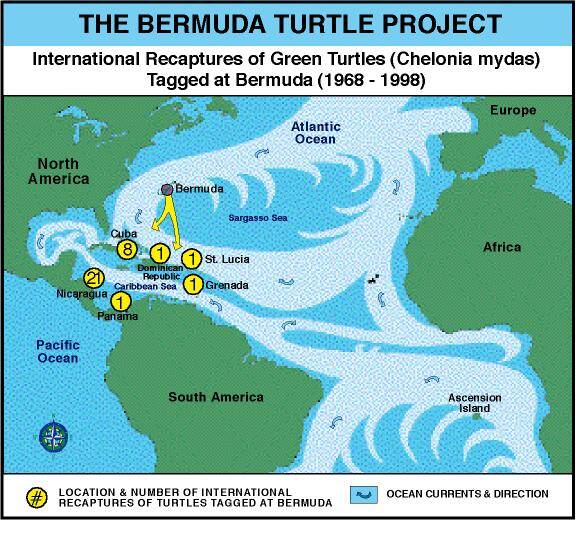 One of the places where little turtles were taken by the thousands for release was the tiny island nation of Bermuda. Caribbean in climate and appearance, Bermuda is actually almost due east of Cape Hatteras, North Carolina. Old sailors’ logs tell of great fleets of turtles in the waters around Bermuda as well as healthy nesting populations around the island. By 1620, the government was sufficiently concerned about the wanton exploitation of the turtle resource to pass “An Act Agaynst the Killing of Ouer Young Tortoyses,” which is the earliest known legislation regarding sea turtles anywhere in the world. Unfortunately, the law failed to halt the extirpation of the breeding colony, and by the 1920s nesting by green turtles had ceased on the island. Thus, by the time Dr. Carr and the STC had been formed in 1959, the nesting population had been entirely wiped out in Bermuda and only immature green turtles were found to inhabit the island’s extensive shallow-water habitats.
One of the places where little turtles were taken by the thousands for release was the tiny island nation of Bermuda. Caribbean in climate and appearance, Bermuda is actually almost due east of Cape Hatteras, North Carolina. Old sailors’ logs tell of great fleets of turtles in the waters around Bermuda as well as healthy nesting populations around the island. By 1620, the government was sufficiently concerned about the wanton exploitation of the turtle resource to pass “An Act Agaynst the Killing of Ouer Young Tortoyses,” which is the earliest known legislation regarding sea turtles anywhere in the world. Unfortunately, the law failed to halt the extirpation of the breeding colony, and by the 1920s nesting by green turtles had ceased on the island. Thus, by the time Dr. Carr and the STC had been formed in 1959, the nesting population had been entirely wiped out in Bermuda and only immature green turtles were found to inhabit the island’s extensive shallow-water habitats.
STC Board member and philanthropist Dr. Clay Frick, who owned a home in Bermuda (on what is now known as Frick Island) took a keen interest in the hatchling release program and in the little turtles found around the island. Dr. Frick and his family took up the cause to help recover Bermuda’s turtles, assisting STC with the hatchling shipments from Costa Rica and launching what is now known as the Bermuda Turtle Project (BTP). The BTP was formally initiated in 1968 by Dr. Frick, in cooperation with the Bermuda Government. Since 1991, the project has been a collaborative effort of STC, BZS and Drs. Anne and Peter Meylan. Throughout its history, the program has received financial support from the Frick family. Work carried out under the Bermuda Turtle Project falls into three main project activities: 1) Gathering data about Bermuda’s Sea Turtles; 2) Training Scientists; and 3) Public Education.
The research efforts of the BTP Project are focused on filling in the information gaps on green turtle biology so that successful protection may be given to these vanishing animals. Bermuda is one of a few locations worldwide where post-pelagic, immature green turtles occur in the complete absence of adults. It may be the best site in the world where green turtles of this age can be studied in their natural habitat. Whereas most studies of sea turtles take place on nesting beaches, Bermuda provides scientists and resource managers with a unique opportunity to study the little understood juvenile stage of the green turtle.
In addition to annual research, every year since 1996 the BTP has offered an in-water course on sea turtle biology and conservation. It brings students and scientists from around the world to Bermuda to study the pelagic and juvenile phases of the marine turtle life cycle, turtle biology and conservation through observation of the animals in their marine habitat, necropsies, and a capture-tag-release study. Click here to apply for this year’s course!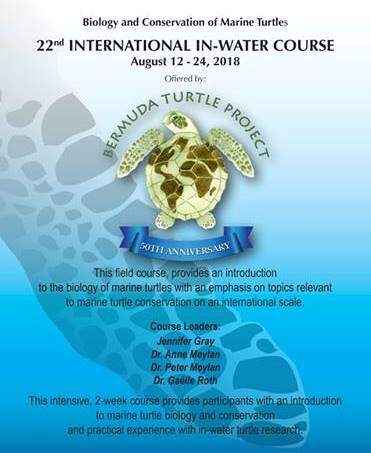
As of 2018, about 4,000 individual green turtles and 140 hawksbills have been captured by the project, tagged and released so that information can be obtained on size structure of the population, genetic identity, sex ratios, growth rates, site fidelity, and migratory patterns. More than 1,000 recaptures have been made of tagged green turtles by the project in Bermudian waters, providing one of the best data sets in the world on growth rates and movements of free-ranging, immature green turtles. Green turtles tagged in Bermuda have been captured as far away as Cuba, Nicaragua and Venezuela; the long-distance tag returns are particularly important because they shed light on the migrations of the green turtles that grow up in Bermuda waters.
A recently-completed genetic survey carried out as part of the Bermuda Turtle Project found that green turtles that grow up in Bermuda come from several nesting beaches, including Florida, Costa Rica and northern South America – many of the places where STC carries out systematic nesting beach monitoring and conservation projects for green turtles.
Satellite tracking has revealed important information about the use of home ranges by green turtles in Bermuda. They appear to utilize a particular spot near coral reef or rocks to sleep at night and then return to a main foraging ground during the day to graze on sea grasses. At a certain point in their maturity, they depart Bermuda waters, often following a bee-line route, to join an adult turtle colony, where they likely remain for the duration of their lives, aside from bi-annual migrations to their natal beaches (where they were born) to mate and nest.
Over the last half century, the Bermuda Turtle Project has discovered nearly everything that is known about the biology and life history of Bermuda’s sea turtles. In the process, the project has provided training for generations of sea turtle biologists and helped contribute to global sea turtle conservation efforts. The ongoing work to protect green turtles that reside in Bermuda during an important phase of their lives is helping recover this species in the Western Hemisphere. And STC’s sustained research and conservation programs in the US, Caribbean and Latin America have been credited with saving the Atlantic green turtle from near extinction and improving the survival outlook for many other turtle populations. We hope STC members and supporters will join us in celebrating the Bermuda Turtle Project’s 50th anniversary, and we invite you to watch our new documentary about the project, which is available above and online here: https://youtu.be/rbFLJ4z1tIk
STC Programs: Research: Assistantships for Sea Turtle Monitoring in Bocas del Toro Region, Panama
Bastimentos Island National Marine Park
Since 2003, Drs. Anne and Peter Meylan have worked in partnership with the Sea Turtle Conservancy (STC) to monitor important Panamanian sea turtle nesting beaches in the Bocas del Toro Province and the Comarca Ngäbe Buglé, from the Changuinola River to the Chiriquí River. Key among these beaches are three in the Bastimentos Island National Marine Park, Small Zapatilla Cay, Big Zapatilla Cay and Playa Larga. For the 2018 nesting season, they anticipate having up to 6 openings for research assistants to help with this work.
Application Information for Research Assistant Positions
Research Assistantship (RA) positions are voluntary (unpaid) and selected RAs are expected to plan and finance their own travel to and from Bocas del Toro, Panama. Selected RAs will receive board and lodging in small field camps and will be expected to help with cooking and clean-up.
Good knowledge of Spanish and English is required. Applicants with: 1) education in biology or related fields, 2) previous fieldwork with sea turtles, and 3) experience working/living in multicultural environments in isolated locations for extended periods will be most competitive for these positions. Availability for the entirety of one specified time interval for the BINMP program (27 April through 31 July or 25 July through 2 November) is preferred.
STC Alumni RAs have gone on to work for conservation organizations, universities and government agencies worldwide.
Applications for RA positions must include the following materials:
Completed materials should be emailed to Peter Meylan (meylanpa@eckerd.edu), Anne Meylan (anne.meylan@myFWC.com), and Cristina Ordoñez at cristinao@conserveturtles.org.
All application materials must be received at our office before or on the deadline listed for each program. Short-listed candidates will be contacted within four weeks of the application deadline. Please do not phone or e-mail to inquire about the status of your application.
Applicants that do not supply all requested materials will not be considered.
2018 BINMP Program Research Assistant Position Information:
Project description: Conservation and monitoring of hawksbill and leatherback sea turtles
Location: Bocas del Toro Province, Bastimentos Island National Marine Park (BINMP)
Dates: Group 1: 27 April – 31 July 2018
Group 2: 25 July – 2 November 2018
Applications will be accepted until all positions are filled.
Project summary:
Since 2003, Anne and Peter Meylan have worked in a partnership with the Sea Turtle Conservancy (STC) to monitor important Panamanian sea turtle nesting beaches in the Bocas del Toro Province and the Comarca Ngäbe Buglé, from the Changuinola River to the Chiriquí River. Four sea turtle species are found in the waters of Bocas del Toro and the Comarca; Leatherback (Dermochelys coriacea), Hawksbill (Eretmochelys imbricata), Green (Chelonia mydas) and Loggerhead (Caretta caretta). Within this region, we have standardized monitoring, research and protection efforts in collaboration with STC and members of local communities close to the nesting beaches. This program has had very positive results. Nearly 1,000 hawksbill nests were recorded in the park in 2017. In the last 14 years, there has been a reduction in the illegal killing of turtles on the majority of nesting beaches in the area, and an increasing nesting trend for both Leatherback and Hawksbill turtles. Despite these advances, numerous threats remain for the sea turtles within and adjacent to BINMP, including increasing pressure on coastal and marine habitats through unregulated tourism development and the continued hunting of turtles for personal consumption and commercial purposes both on the beach and within park waters.
Work description:
Up to 6 research assistants (RAs) will be trained in sea turtle monitoring techniques by, and work under the supervision of, the Meylans (Eckerd College and the Florida Fish & Wildlife Conservation Commission) and Cristina Ordoñez, STC’s Panama Coordinator. The season is divided into two time periods that together span the majority of the hawksbill nesting season in BINMP: May through July and August through October. The beach monitoring team will be made up of local Panamanians with moderate to extensive experience with the project and RA’s from multiple countries around the world. The primary responsibilities of the RAs will include day time census patrols, night time tagging patrols, and logistic support of all camp activities. Day time patrols include identifying and accurately recording all emergence and nesting activity, marking of nests for future hatching success evaluation, and performing excavations of hatched nests. Night time patrols include tagging and measuring nesting females. All RA’s are expected to contribute to recording data, maintaining the camp, cooking and cleaning, making food trips to town, and other activities in support of the project.
RAs can expect to work very long hours, throughout the day and night, often with little sleep. Beach patrols require walking between 6 to 12 kilometers in soft sand and in extreme weather conditions. Night time patrols are 5 hours long (8 pm – 1 am or 1 am to 6 am). Therefore excellent physical condition is a requirement for the RA positions.
The work will be developed in three different beaches in Bastimentos Island National Marine Park (BINMP): “Small” Zapatilla Cay (Zapatilla Uno), “Big” Zapatilla Cay (Zapatilla Dos), and Long Beach (Playa Larga). RAs will rotate among the three beaches while participating in the sea turtle program and may have an opportunity to work for short periods at other sites in the region.
For additional information about the project and to download an application, visit http://stcturtle.org/////stc-programs-research-assistantships-sea-turtle-monitoring-bastimentos-island-national-marine-park/